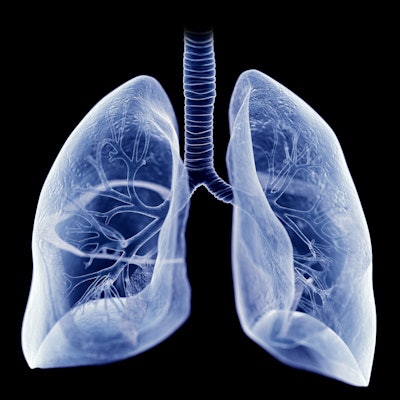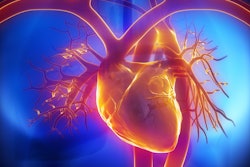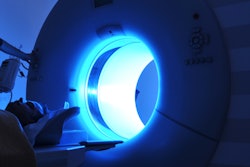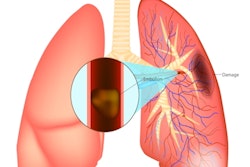
Low-dose chest CT (LDCT) combined with AI is effective for identifying pulmonary arteriovenous malformations in children, according to a presentation delivered September 7 at the International Society of Computed Tomography (ISCT) meeting in San Diego.
Pairing the exam with convolutional neural network (CNN) denoising reduces its radiation dose so that it approaches that of a conventional chest x-ray, presenter Zaid Saadeh, MD, of the Mayo Clinic College of Medicine and Science in Rochester, MN, told session attendees.
Pulmonary arteriovenous malformations can form in patients with hereditary hemorrhagic telangiectasia -- a disease that causes abnormal connections to develop between arteries and veins -- at an incidence that ranges between 15% and 50%. The condition is often asymptomatic until complications such as stroke develop, Saadeh noted.
Children with hereditary hemorrhagic telangiectasia are regularly screened with contrast echocardiography, he said. But since patients must often be imaged multiple times, there's concern that they are being exposed to a high cumulative radiation dose.
To address this problem, Saadeh and colleagues developed a low-dose CT angiography (CTA) protocol to screen for pulmonary arteriovenous malformations in pediatric patients with hereditary hemorrhagic telangiectasia. They investigated whether a scanning technique that would incorporate a CNN-based denoising method would produce clinical-quality images of these malformations.
Their study included 15 children with a hereditary hemorrhagic telangiectasia diagnosis who underwent low-dose CT angiography. Of these 15 patients, 13 had pulmonary arteriovenous malformations identified on prior contrast echocardiography or invasive angiography exams.
What Saadeh and co-authors called a "projection-based noise insertion technique" was used to simulate CTA images taken with 25% of a typical dose; then the investigators applied a CNN-supported protocol to these study cases. Blinded to the method, two thoracic radiologists evaluated the scans for presence of pulmonary arteriovenous malformations. The researchers then assessed the quality of the images, spatial resolution, and noise between the CNN-supported CTA protocol and the projection-based noise insertion one.
Saadeh's team found that the CNN-supported CTA protocol showed high sensitivity and specificity, as well as high interreader agreement (87%).
| Performance of a CNN-based CTA chest imaging protocol compared with a projection-based noise insertion technique | ||
| Measure | Projection-based noise insertion technique protocol (simulating 25% of typical dose) | CNN-based protocol |
| Reader 1 | ||
| Sensitivity | 69% | 85% |
| Specificity | 50% | 100% |
| Reader 2 | ||
| Sensitivity | 84% | 100% |
| Specificity | 50% | 100% |
Saadeh et al also found that quality, spatial resolution, and artifact ratings for the CNN-based CTA protocol were better compared to the projection-based noise insertion technique.
Not only does the CNN-based protocol show promise for better diagnosis of pulmonary arteriovenous malformations but it also could curb healthcare costs, Saadeh and colleagues concluded.
"A change in pulmonary arteriovenous malformations screening and follow-up integrating low-dose chest CT could reduce cost and burden associated with false positive results," they wrote in an abstract about their research.





















